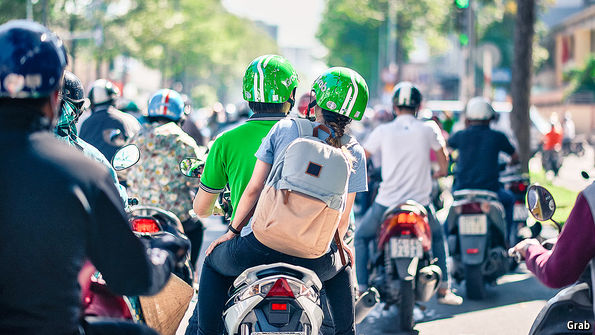SCOOTER-DRIVERS in bright green helmets enliven the dusk of rush hour in Ho Chi Minh City, Vietnam’s commercial centre. This conspicuous fleet is carrying round clients of Grab, a South-East Asian ride-hailing firm.
Its operations, connecting travellers with taxis, private cars and motorbike taxis in six countries, straddle a region that is twice as populous as America and swiftly urbanising. Its future seems assured, if it can compete with Uber, a deep-pocketed American competitor.
A big chunk of the $1bn of cash that Grab holds for investing purposes will be ploughed into its digital-payments system, “GrabPay”, which started operating in January 2016.

In November 2016 Grab updated GrabPay, turning it from a digital-payments processor which was mostly of use to people who already had credit and debit cards, to a digital wallet which South-East Asians can top up with credit by making cash payments at banks and some convenience stores. At present people mainly use GrabPay to pay for Grab rides, but the aim is that customers will eventually use it to buy all manner of daily items.
But such dreams depend on Grab seeing off local rivals and defending its business from Uber, which is roughly 20 times as valuable. Grab’s investors include Temasek, Singapore’s state investment firm, and China Investment Corporation, a Chinese one.
In September, SoftBank, a Japanese telecoms and technology firm that is owned by Masayoshi Son (who last year announced a $100bn tech-investment fund in partnership with Saudi Arabia and other investors), led a group that put $750m into Grab, valuing it at more than $3bn.

Uber operates in all the same countries—Indonesia, Vietnam, the Philippines, Thailand, Malaysia and Singapore—but in 20 cities compared with Grab’s 34. The American firm last year suffered a setback which, paradoxically, makes it a stronger rival: in August it abandoned its costly efforts to crack China, and sold its business there to Didi Chuxing, a local competitor which is also an investor in Grab. The deal freed up resources which Uber is now using to push deeper into Grab’s territories.
Grab still claims to have services that are better suited to South-East Asians. Mr Tan points to its GrabHitch offering, for example. Many people in Jakarta, Indonesia’s capital, live in suburban developments many miles from the central business district, and make long journeys on their scooters into work every day.
GrabHitch allows them to advertise the route and time of their trip in the hope of finding someone who wants to hitch a lift on the back of their scooter, paying a nominal sum to cover petrol and bike-maintenance costs. Uber doesn’t offer anything as informal or low-priced.

Indonesia is a key battleground: its population of 257m accounts for more than one-third of the region’s people. Since launching its motorbike taxis in Jakarta in May 2015, Grab has gradually overhauled the lead formerly enjoyed by Go-Jek, a local ride-hailing business, and seems to be drawing ahead.
Uber, which came late to the market, is now in third place. On February 2nd Grab said it will invest $700m into Indonesia over the next four years. For Grab, South-East Asia’s traffic-clogged mega-cities are not “just another” market, says Mr Tan. “This is our home.”
Source : Economist


















